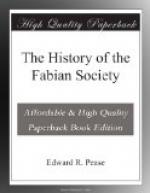Six members of the Society were candidates, but none of them belonged to the group which had made its policy and conducted its campaign. In one case, Ben Tillett at West Bradford, the Society took an active part in the election, sending speakers and collecting L152 for the Returning Officer’s expenses. Of the six, J. Keir Hardie at West Ham alone was successful, but Tillett did well at West Bradford, polling 2,749, only a few hundred votes below the other two candidates, and preparing the field for the harvest which F.W. Jowett reaped in 1906.
The result of the election, which took place in July, was regarded as a justification for the Fabian policy of social advance. In London, where Liberalism was strongly tainted with it, the result was “as in 1885,” the year of Liberal victory, and the only Liberal seat lost was that of the President of the Leasehold Enfranchisement Association! In the industrial cities, and in Scotland, where Liberalism was still individualist, the result was rather as in 1886, when Liberalism lost. In London also “by far the largest majorities were secured by Mr. John Burns and Mr. Keir Hardie, who stood as avowed Socialists, and by Mr. Sydney Buxton, whose views are really scarcely less advanced than theirs."[29]
I have pointed out that Fabian policy began with State Socialism, and in quite early days added to it Municipal Socialism; but in 1888 the authors of “Fabian Essays” appeared to be unconscious of Trade Unionism and hostile to the Co-operative movement. The Dock Strike of 1889 and the lecturing in London clubs and to the artisans of the north pointed the way to a new development. Moreover, in the summer of 1892 Sidney Webb had married Miss Beatrice Potter, author of an epoch-making little book, “The Co-operative Movement,” and together they were at work on their famous “History of Trade Unionism.”




